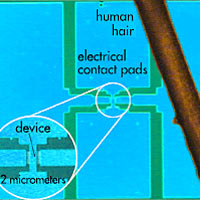Fan Micro Car DIY STEM Kit
$9.99$4.95
Posted on: Jan 22, 2004

It measures just a few micro-meters square and is hundreds of times smaller than typical microwave signal generators in use today in cell phones, wireless Internet devices, radar systems and other applications.
Image courtesy: NIST
A tiny, novel device for generating tunable microwave signals has been developed by researchers at the National Institute of Standards and Technology (NIST). Described in the Jan. 16 issue of Physical Review Letters, the device measures just a few micro-meters square and is hundreds of times smaller than typical microwave signal generators in use today in cell phones, wireless Internet devices, radar systems and other applications.
The device works by exploiting the fact that individual electrons in an electric current behave like minuscule magnets, each one with a "spin" that is either up or down, just as an ordinary magnet has a north and a south pole.
The NIST device consists of two magnetic films separated by a non-magnetic layer of copper. As an electric current passes through the first magnetic film, the electrons in the current align their spins to match the magnetic orientation in the film. But when the now aligned electrons flow through the second magnetic film, the process is reversed. This time the alignment of the electrons is transferred to the film. The result is that the magnetization of the film rapidly switches direction, or oscillates, generating a microwave signal. The microwave signal can be tuned from less than 5 gigahertz (5 billion oscillations a second) to greater than 40 GHz.
The NIST experiments confirm predictions made by theorists at IBM Corp. and Carnegie Mellon University in 1996.
NIST physicist William Rippard says the new oscillators can be built into integrated circuits with the same technologies now used to make computer chips and that they may eventually replace bulkier technologies at a greatly reduced cost.
 'There must be no barriers for freedom of inquiry. There is no place for dogma in science. The scientist is free, and must be free to ask any question, to doubt any assertion, to seek for any evidence, to correct any errors.'
'There must be no barriers for freedom of inquiry. There is no place for dogma in science. The scientist is free, and must be free to ask any question, to doubt any assertion, to seek for any evidence, to correct any errors.'